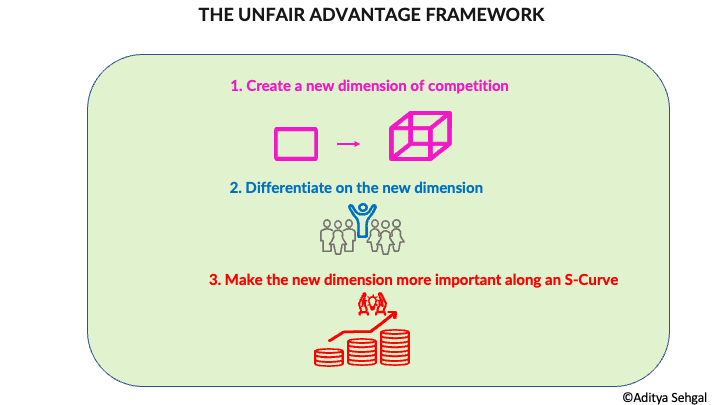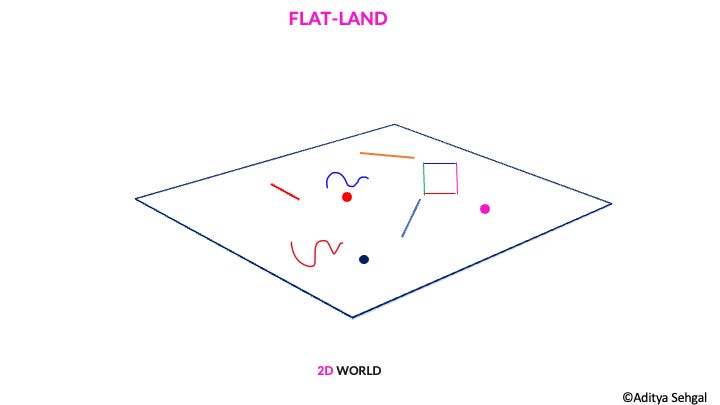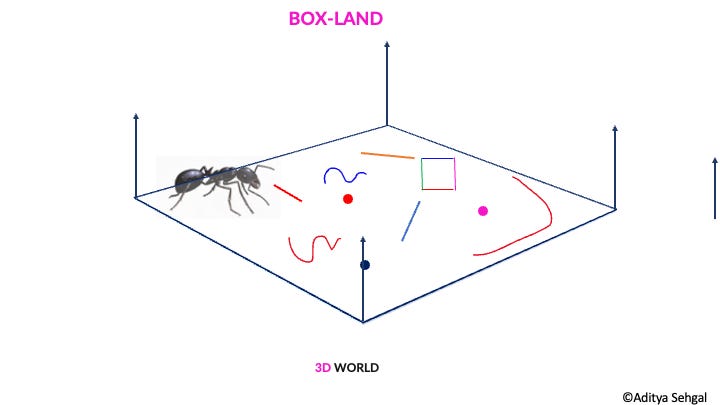The Framework:
“Any sufficiently advanced technology is indistinguishable from magic’- Arthur C Clarke’s third law.
To illustrate this framework, let’s look at a fictional world called Flat-land. Flat-land is a 2 Dimensional world. Let’s call the locals’ ‘Flatties’.
Flatties come in just two types - either a dot or a line. Flat-world cannot accommodate anything else.
Flatties have a hierarchy.
A line is more significant than a dot. A more prominent line is more important than a small line. Lines can have different colours. They can have structure - some are boxes or worms, but they show up as lines when anyone else looks at them.
Boxes and worms are distinctive in Flat-land. They are the ‘market leaders’ because they can do things that others can’t - Boxes seem to change colour depending on which side you look. Worms seem to be ‘elastic’ - they can be longer or shorter depending on how they are coiled and how you view them.
Now, let’s say an ant wanders into Flat-land. The Ant is a resident of a different 3-dimensional world called box-land.
To the Flatties, the Ant will appear as six dots since each leg will look like a dot. Most of the Ant will be above Flat-land and be ‘invisible’. As the Ant walks, it lifts its legs and puts them back down - This is magic for the Flatties - they will see dots disappearing and appearing out of thin air as the Ant’s feet touch down.
The Ant is a god in Flat-land - it can do ‘Magic’. The Flatties can not compete with it.
There are no secrets from the Ant - It can see ‘inside’ the square Flatties. It can appear and disappear. It can pick up the Flatties and make them disappear by throwing them ‘out of the world’.
Eventually, most Flatties will learn about the new technology called ‘Height’ - and now magic will be demystified by ‘science’.
Applications:
This framework is universal: It is relevant to every business and category.
There are generally ‘rules of the game’ codified by regulators. Creating a new dimension of competition helps to generate ‘Regulatory Innovations’. In my “Innovation Pyramid Framework,’ I had demonstrated that ‘Regulatory innovation’ is the most impactful type of innovation. One ‘Regulatory innovation’ enables multiple ‘Business model innovations’ and many ‘Product innovations’.
The new dimension will become more relevant over time in an S-Curve (more of that in a future Framework)
To begin with, it will convert early adopters and enthusiasts.
The market incumbents will typically ignore the new dimension - they will leverage their scale and try and do what they already do even better. They will feel that their ‘brand name’ and ‘consumer loyalty’ will mean that the new idea will fail.
At some point, adoption will reach a tipping point to early mass-market consumers. By this time, you can build up a very significant technical lead on your chosen dimension compared to the incumbents, and it will be challenging for them ever to catch up.
Eventually, the new dimension will convert the whole market, and the innovator would have leveraged their ‘unfair advantage’ to a position of market leadership.
Every leading brand or service in every industry, market, vertical or company, has defined a new dimension and owned/driven it at some time in its history.
Some examples:
Electric Vehicles:
After achieving parity with gas cars on the range, looks and comfort, Tesla defined new competitive dimensions:
Electric propulsion (Environmental benefits)
Sports-car acceleration in a family car (an Electric motor has higher torque)
Zero maintenance - few moving parts
In the beginning, these were not crucial decision factors for consumers. Over time they have become the key factors driving choice. Markets like China already have over 25% EV penetration, and in many countries, Tesla is already No 1 in the segments it competes.
Incumbents have been playing catch up with EV technologies and have poured in billions to try and catch up ‘Tesla’s unfair advantage’. The jury is out whether they will be able to do so.
Music: High capacity hard disks created a new dimension vs CDs where you could have thousands of songs on a device. This innovation killed Discman and created iPod and iTunes. Spotify started differentiation on streaming ‘all the music’ for ‘one monthly cost’ - this disrupted the iTunes store, which was the crown Jewel of the Apple ecosystem.
Using the framework:
Know that EVERY product and market will be disrupted in the near to mid future by someone finding a new dimension of competitiveness.
The risk is even higher since many startups are focused on different dimensions. The probability of one of these thousands of people attacking every business to ride a new dimension to glory is very high.
If you are an established business, how can you set up multiple small ‘fast’ experiments and self-contained teams to find a way to disrupt your business yourself.
Map your industry and look at your current competitors - is someone redefining the essential axes of your industry, and are you missing the trend? Look for the tiny players in blogs and memes. Is there anyone performing ‘magic’ or ‘mumbo-jumbo’ which you don’t understand?
Talk to extreme consumers who hate your product or service - what dimension are you missing which causes them to hate your product?
Brainstorm around all the new dimensions you could add to your product/service/market. If you assume that the dimension could become the primary discriminator of consumer choice in your market, what would that look like - in what time frame could you achieve it?
How can you test it quickly? If you find and validate a candidate dimension at a small scale, how can you put disproportionate resources into a) leading the dimension and b) making the dimension more relevant to consumers as the critical decision variable.
Personal development: This is a robust framework for self-development. Finding new dimensions of knowledge and then finding ways to make them relevant to your role is an excellent way to create ‘magic’ at work and become successful.







Hi Aditya, I'm new to your newsletter but loving it already. The ant/flatties analogy is very helpful in grasping the framework.
Long comment alert so here's my TL;DR question: Do you think an unbundling-bundling cycle can be seen as a part of the Unfair Advantage framework?
It seems to me that a new dimension of innovation follows a cycle of unbundling and rebundling. For example, the value proposition of a Tesla initially was distilled/unbundled to its eco-friendliness. As battery technology improved and delivering on that eco promise became more feasible, the price became affordable for a bigger market. And then the gold-standard parameters of looks, comfort, and safety were bundled into the eco-friendly dimension to offer a complete package better than the current best.
Similarly, CDs unbundled into individual MP3 which were of lower quality. But it gave optionality to listeners and that market expanded until the subscription model of Spotify rebundled songs into playlists.